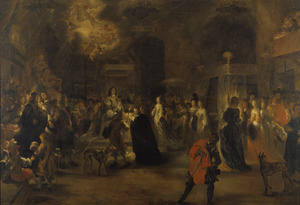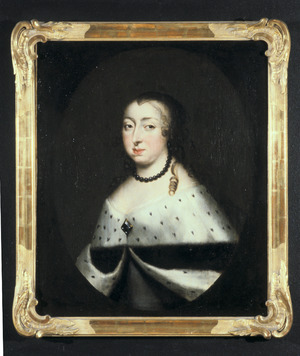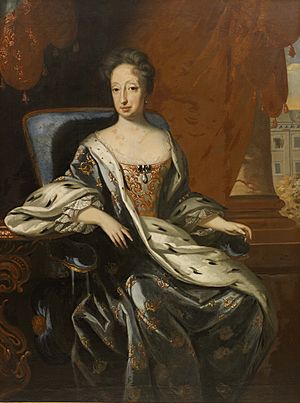Hedwig Eleonora of Holstein-Gottorp facts for kids
Quick facts for kids Hedwig Eleonora of Holstein-Gottorp |
|
|---|---|
 |
|
| Queen consort of Sweden | |
| Tenure | 24 October 1654 – 13 February 1660 |
| Coronation | 27 October 1654 |
| Born | 23 October 1636 |
| Died | 24 November 1715 (aged 79) |
| Spouse | |
| Issue | Charles XI of Sweden |
| House | Holstein-Gottorp |
| Father | Frederick III, Duke of Holstein-Gottorp |
| Mother | Duchess Marie Elisabeth of Saxony |
Hedwig Eleonora of Holstein-Gottorp (born 23 October 1636 – died 24 November 1715) was the Queen of Sweden from 1654 to 1660. She was married to King Charles X Gustav. After her husband's death, she became a powerful regent. She ruled Sweden while her son, King Charles XI, was too young (1660–1672). She also served as regent for her grandson, King Charles XII, in 1697. Later, she represented Charles XII when he was away fighting in the Great Northern War (1700–1713). Hedwig Eleonora was known for her strong personality. She was seen as the most important woman at the royal court for 61 years, from 1654 until she passed away.
Contents
Biography
Early Life and Marriage Plans
Hedwig Eleonora was born on 23 October 1636. Her birthplace was the Palace of Gottorp in Schleswig. Her parents were Duke Frederick III of Holstein-Gottorp and Marie Elisabeth of Saxony. She was one of their sixteen children.
When she was 18, she married King Charles X Gustav of Sweden. Their wedding took place on 24 October 1654. This marriage was planned to create an alliance. Sweden and Holstein-Gottorp wanted to be allies against their common enemy, Denmark.
Queen Christina of Sweden met Hedwig Eleonora before the wedding. Christina had just given up her throne. She suggested that Charles Gustav should marry Hedwig Eleonora. Holstein-Gottorp quickly agreed to all of Sweden's requests. This made the wedding plans go very fast. Charles Gustav chose Hedwig Eleonora because he thought she was beautiful.
Life as Queen
Hedwig Eleonora arrived in Sweden on 5 October 1654. King Charles X Gustav welcomed her. Her wedding was held at the Stockholm Royal Palace on 24 October. She was crowned Queen at Storkyrkan on 27 October.
Soon after, her husband left for Poland. He went to fight in a war called the Deluge (history). Hedwig Eleonora stayed in Sweden. Their son, Charles XI, was born on 24 November 1655.
In the spring of 1656, she joined her husband's military campaign. She showed great strength during this time. She was present at the Battle of Warsaw (1656). The Swedish army praised her alongside her husband. She returned to Sweden in the autumn of 1656. There, she took charge of her own lands. She managed these lands carefully throughout her life.
During the Dano-Swedish War (1658-1660), she stayed at Kronborg in Denmark. This castle had been captured by Swedish forces. She entertained foreign ambassadors there. She also visited other palaces and went hunting. In December 1659, she traveled to Gothenburg. The Swedish parliament was set to meet there.
Leading the Country as Regent
Her husband died on 13 February 1660. Hedwig Eleonora then became the leader of Sweden. She was the head of the Regency Council for her young son, Charles XI. Her husband's will stated that she should have two votes. This meant her decision was more important than others.
The council members did not like this plan. They questioned if she should attend meetings. But Hedwig Eleonora made it clear she wanted her husband's wishes to be followed. She attended almost all council meetings. She wanted to protect her son's rights. She made sure she knew about all decisions.
Hedwig Eleonora did not like war. She supported peace in the council. She helped achieve the Peace of Oliva. She also stopped a war against Russia. This was one of the few times she strongly pushed her own will. She later said she disliked politics and diplomacy. Her son, Charles XI, never blamed her for any mistakes made by the government during her regency.
After her son's death on 5 April 1697, Hedwig Eleonora became regent again. This time, it was for her grandson, Charles XII. This regency was short. It lasted until Charles XII was declared old enough to rule later that year. She supported a marriage alliance for her granddaughter, Hedwig Sophia. She also oversaw the building of many grand homes and palaces. One famous example is Drottningholm Palace. She spent a lot of money to make the court look grand again.
Life as Queen Dowager
Hedwig Eleonora was highly respected as a queen dowager. She focused on managing her lands. She also focused on raising her son, Charles XI. She taught him about religion and good morals. She also encouraged him to be physically active. Some people thought she spoiled him by letting him skip his studies. But she believed it was more important for him to be healthy.
In 1661, she was considered as a possible wife for King Charles II of England. However, she refused. She said she wanted to remain loyal to her late husband.
A young nobleman named Count Carl Gyllenstierna became her chamberlain in 1667. He became her close advisor. He was promoted quickly at court. He was known for his good looks. There is a story that his home, Steninge Palace, had a secret passage. This passage supposedly led from his room to the Queen's Wing. Hedwig Eleonora often visited there.
Later in her life, Hedwig Eleonora had a close relationship with another advisor, Anna Catharina von Bärfelt. This caused a conflict with Gyllenstierna. Bärfelt was known for taking gifts from people who wanted to see the queen dowager. Gyllenstierna and other court members worked together to have Bärfelt removed from court.
Hedwig Eleonora kept in touch with her German relatives. She often hosted them. She raised her niece, Magdalena Sibylla of Hesse-Darmstadt. She also raised her late husband's niece, Juliana of Hesse-Eschwege. Juliana was once thought to be a future queen. However, this plan changed when Juliana had a child. Hedwig Eleonora sent Juliana away.
She had a very close bond with her son, Charles XI. He trusted her completely. She traveled with him often. During the Scanian War, she stayed closer to the war front. This allowed him to visit her. Even after Charles XI married Ulrike Eleonora of Denmark, Hedwig Eleonora remained the most important woman at court. Charles XI called his mother "The Queen." He called his wife simply "My Wife." Foreign ambassadors always greeted Hedwig Eleonora first.
Charles XI often talked about state matters with his mother. She respected his opinions. He usually followed her advice. It is believed she influenced his decisions on religion and art.
Her grandson, Charles XII, also respected her greatly. There is a famous story about him. He was celebrating with his brother-in-law. Hedwig Eleonora saw him. She gave him a long look and turned away. Charles XII immediately promised her he would never drink wine again. He kept this promise.
During the Great Northern War, she represented her grandson. She met with foreign ambassadors. Some reports say she was very quiet with them. Others say she sometimes laughed at them.
Hedwig Eleonora was closest to her older granddaughter, Hedwig Sophia of Sweden. After Hedwig Sophia passed away, she supported her son, Charles Frederick, Duke of Holstein-Gottorp. She wanted him to be the next king after Charles XII. In 1713, she had to convince her younger granddaughter, Ulrika Eleonora of Sweden, to become regent. She also supported Ulrika Eleonora's marriage to Frederick I of Sweden. She hoped this would make it easier for Charles Frederick to become king.
Hedwig Eleonora was described as strong and determined. People at court liked her humor. She enjoyed parties. Her employees saw her as strict but fair. She loved architecture and painting. She also enjoyed playing cards. She was known for playing late into the night.
After her official mourning period ended in 1663, she hosted many parties. She opened the theatres Bollhuset and Lejonkulan. She also helped establish Sweden's first spa, Medevi, in 1688. She supported artists like Nicodemus Tessin the Younger and David Klöcker Ehrenstrahl.

See also
 In Spanish: Eduvigis Leonor de Holstein-Gottorp para niños
In Spanish: Eduvigis Leonor de Holstein-Gottorp para niños





